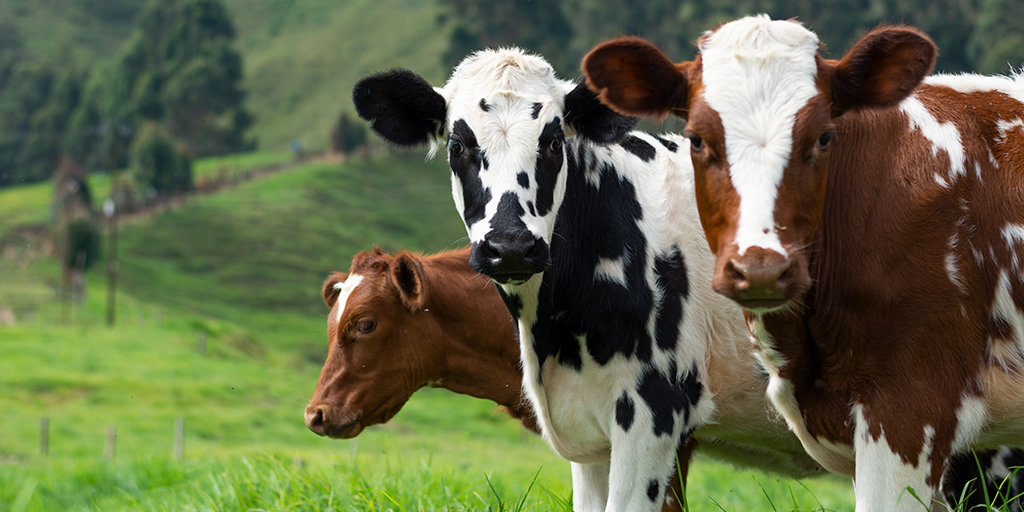Mineral deficiencies can be a silent killer for cows, with symptoms often remaining hidden for some time. Each Spring, we unfortunately see a number of cows become severely unwell with grass tetany or milk fever, which occur when certain minerals fall below critical levels.
In this blog we explain the key risk factors, symptoms to look out for and preventative actions you can take when it comes to grass tetany and milk fever in cows.
Preventing grass tetany in cows
Cattle need a continuous supply of magnesium for growth, development and reproduction. It’s not stored in the body, so it’s important that they obtain sufficient amounts of magnesium through their feed. Severe magnesium deficiencies can cause grass tetany in lactating cows, which can be fatal.
Most cases of grass tetany are seen in early spring when grass-dominant pastures are rich in nitrogen yet lacking magnesium. Grass tetany occurs when magnesium levels fall beneath critical levels (known as hypomagnesemia), which can cause cattle to experience muscle spasms and convulsions, and often death. Progression of grass tetany can be quite quick, so it’s important to contact your vet immediately if you notice any symptoms.
- At risk: Lactating cows with young calves are most vulnerable to grass tetany. Very thin or very fact cows are also more at risk.
- Signs to look out for: Initial signs include twitching of the ears and face and a stiff gait. As the condition progresses, cows can appear to have a “goosestep,” bellow and start to stagger.
- Diagnosis & treatment: Unfortunately, sudden death is often the first sign of a grass tetany outbreak. If caught early, a vet can diagnose the condition based on clinical signs. Treatment is typically calcium and magnesium injections followed by daily supplementation of magnesium oxide.
- Prevention: Due to the rapid progression of grass tetany, prevention is key. It’s important to discuss your cattle’s diet and nutrition with your vet to formulate a supplement program.
Preventing milk fever in cows
Milk fever typically occurs in dairy cows close or just after calving, but it can also affect high milk production cows. When blood calcium levels become too low to meet the requirement for milk production at calving time, cows can be affected by milk fever (also known as hypocalcaemia). Calcium is one of the most important minerals for cattle, and is vital for many cellular processes, including muscle function and immunity.
Milk fever can cause poor labour, stillborn calves, as well as ultimately death if left untreated. It’s been estimated that up to 50% of cows on their second or third pregnancy suffer from some level of calcium deficiency, so it’s important to keep a careful watch for any warning signs.
- At risk: Dairy cows are most typically affected by milk fever in late pregnancy and after calving. Older cows are at increased risk as they absorb less calcium and are less efficient is accessing bone calcium. Fatter cows are also more vulnerable to the condition.
- Signs to look out for: Lack of appetite, stiff gait and a reluctance to move are the first signs of milk fever. As the disorder progresses, cows will be unable to get up from a lying or sitting position, have heavier breathing, an increased heart rate and a dry muzzle. If left untreated, they will become unresponsive, often develop bloat, and will eventually die.
- Diagnosis & treatment: Milk fever is typically diagnosed based on clinical signs. If you suspect milk fever, an injection of calcium borogluconate should be given as possible.
- Prevention: Due to the high prevalence of milk fever, prevention is key. Your vet will be able to assist in formulating an integrated approach to preventing hypocalcaemia. Key preventative measures include reducing calcium intake before calving to stimulate their calcium regulatory system; feeding as much calcium as possible directly after calving; and replacing green feed with hay for older and fatter cows.
Prevention and treatment strategies
There are a range of preventative measures that can help prevent grass tetany and milk fever in your cows. Your vet is a great resource in developing integrated prevention strategies, as well as formulating treatment plans that can be enacted quickly upon any signs of the disorders.
At Cameron Veterinary Services, our experienced large animal vets can travel to your property to provide top level preventative care and treatment for your cattle.
To book an appointment, call us on 08 8318 1801.



